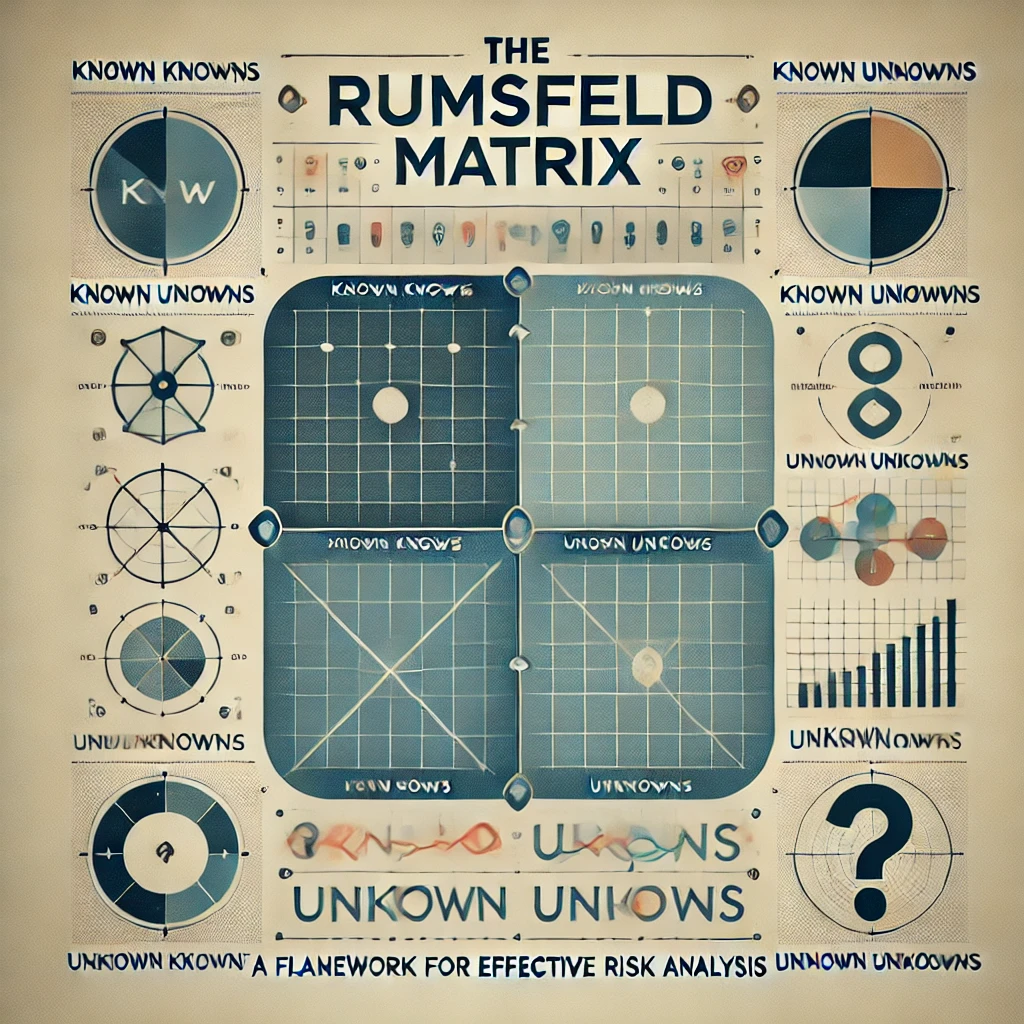Risk is a part of life. Whether you’re making a financial decision, planning a project, or simply trying to decide which route to take on your daily commute, you’re constantly assessing risks. One of the most interesting frameworks for analyzing risk comes from an unlikely source: former U.S. Secretary of Defense Donald Rumsfeld.
In a 2002 press briefing, Rumsfeld introduced a concept that became known as the Rumsfeld Matrix. It’s a surprisingly useful way to think about risk, decision-making, and uncertainty in various aspects of life, from business to personal decisions.
What Is the Rumsfeld Matrix?
The Rumsfeld Matrix is built around four categories of knowledge:
- Known knowns – These are things we know that we know. For example, you know how much money you have in your bank account.
- Known unknowns – These are things we know we don’t know. For instance, you know that you don’t know what the weather will be like next week.
- Unknown knowns – These are things we don’t realize we know. Often, these are subconscious beliefs or assumptions that influence our decision-making.
- Unknown unknowns – These are the most challenging. These are risks or factors we aren’t even aware exist. Think of unexpected events like a pandemic or an economic crisis.
The Rumsfeld Matrix is useful because it encourages us to recognize that we don’t always have perfect knowledge, and that many risks stem from areas we haven’t even considered. By systematically thinking through these categories, we can better identify and mitigate risks in any situation.
Applying the Rumsfeld Matrix in Daily Life
You might think the Rumsfeld Matrix is only for complex political or business decisions, but it can be surprisingly useful in day-to-day situations. Let’s break down how you can use it:
- Assess a personal decision: Say you’re deciding whether to accept a new job offer. You can break down the decision as follows:
- Known knowns: You know the salary, location, and responsibilities of the new job.
- Known unknowns: You don’t know how well you’ll fit into the company culture or how quickly you’ll adapt to new tasks.
- Unknown knowns: You may not realize that you’re more adaptable than you think, based on past experiences in different jobs.
- Unknown unknowns: There could be unforeseen changes in the company, such as a merger or leadership change that could affect your role in ways you can’t predict. By considering these categories, you can make a more informed decision and recognize where to investigate further or accept uncertainty.
- Project management: In a work scenario, the Rumsfeld Matrix can help you anticipate project risks. Imagine you’re leading a team to launch a new product.
- Known knowns: You know the project’s deadlines, budget, and scope.
- Known unknowns: You know that customer demand is uncertain and you don’t know exactly how your team will handle any unexpected challenges.
- Unknown knowns: There may be internal processes or skills within the team you haven’t consciously considered, which could help mitigate risks.
- Unknown unknowns: Market shifts or supply chain disruptions could impact the project in ways you haven’t thought about yet. This framework helps you prepare contingency plans and develop a risk management strategy.
Scenario: Using the Rumsfeld Matrix in a Social Situation
Imagine you’re planning a surprise party for a friend. You want everything to go smoothly, but as with all events, there’s an element of risk. Here’s how the Rumsfeld Matrix can help you plan:
- Known knowns: You know the guest list, the location of the party, and the time of the event.
- Known unknowns: You know you don’t know how the guest of honor will react. Maybe they don’t enjoy surprises as much as you think. You also don’t know if everyone on the guest list will be able to attend on time.
- Unknown knowns: Perhaps you’re underestimating how your friend’s personality—maybe they’re more introverted than you realize—might affect their enjoyment of the party. On a deeper level, you already know some details about their preferences that can help shape the event if you reflect on them.
- Unknown unknowns: There could be a last-minute storm that forces you to change the venue, or perhaps a key guest has an emergency and can’t show up. These are the unpredictable variables you can’t foresee but should be aware of as possibilities.
Using the Rumsfeld Matrix, you can plan for the known unknowns by considering alternatives (such as an indoor backup venue) and mitigate some of the unknown unknowns by staying flexible and keeping the guest list small to minimize unpredictability.
How to Use the Rumsfeld Matrix Effectively
- Start with the knowns: Make a list of what you know and what you need to find out. This helps ground your decision-making and highlights gaps in your knowledge.
- Acknowledge the unknowns: Be honest about what you can’t know. This allows you to prepare for unexpected outcomes and reduces anxiety about uncertainty.
- Develop contingencies: Once you’ve mapped out your known unknowns and possible unknown unknowns, create contingency plans. You can’t eliminate uncertainty, but you can reduce its impact.
- Reassess regularly: As you gather more information, the matrix evolves. Stay flexible and update your understanding as situations change.
A real-life problem that can be effectively solved using the Rumsfeld Matrix is:
Planning a family vacation.
Here’s how the framework can be applied:
Problem:
You’re planning a family vacation to an unfamiliar destination. You want to minimize any potential issues, from budget concerns to weather and logistics.
Applying the Rumsfeld Matrix:
- Known Knowns (things you know you know):
- You know your budget.
- You know your travel dates and the location you want to visit.
- You know how many people will be going and their preferences (activities, accommodations).
- Known Unknowns (things you know you don’t know):
- You don’t know what the weather will be like during your stay.
- You don’t know if the attractions you plan to visit will be crowded or fully operational.
- You don’t know the quality of the local restaurants.
- Unknown Knowns (things you don’t realize you know):
- You might have visited similar places before and have unspoken assumptions about what to expect.
- You might be underestimating your ability to adapt if things don’t go according to plan (past experiences have shown that you are flexible).
- Unknown Unknowns (unforeseen risks or opportunities):
- You could face a sudden flight delay or unexpected political unrest in the region.
- A health emergency might arise, or there could be a natural disaster.
- On the flip side, you might discover a fantastic, unexpected attraction or event.
Solution:
By using the Rumsfeld Matrix, you can plan for both the known unknowns (checking weather forecasts closer to the date, reading reviews of attractions, preparing for different crowd levels) and consider contingencies for the unknown unknowns (getting travel insurance, researching emergency protocols in the area). This method allows for more thorough preparation while keeping you flexible and ready to adapt to surprises, reducing the stress of uncertainty.
Final Thoughts
The Rumsfeld Matrix may have originated in the realm of defense strategy, but it’s a highly adaptable tool for everyday life. By categorizing what you know and acknowledging the uncertainties, you can make more informed decisions, whether you’re choosing a job, managing a project, or even planning a party. Recognizing and preparing for risks, both known and unknown, can help you handle life’s uncertainties with greater confidence.
Incorporate the Rumsfeld Matrix into your decision-making process, and watch as you start to navigate risks more effectively, no matter the situation.



